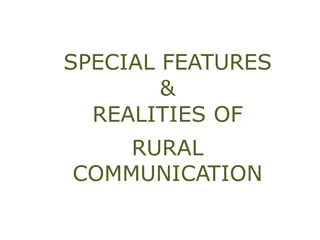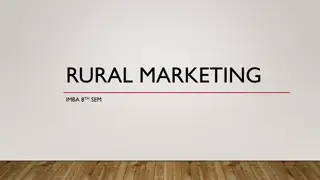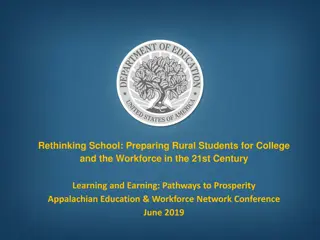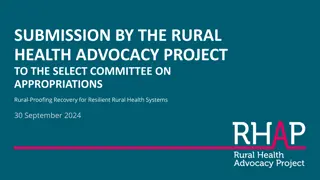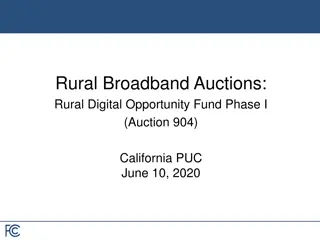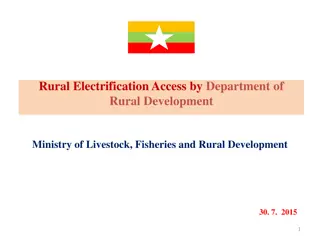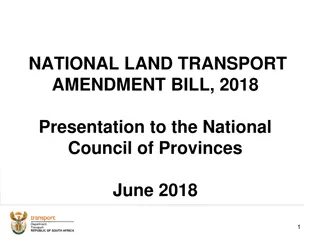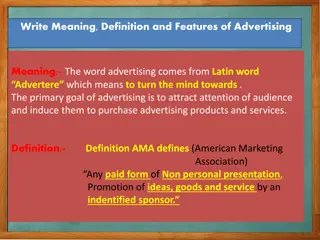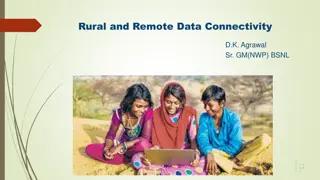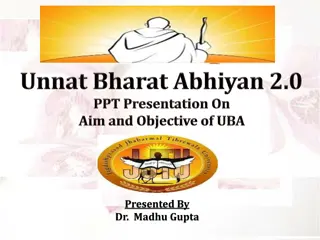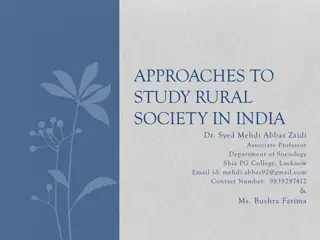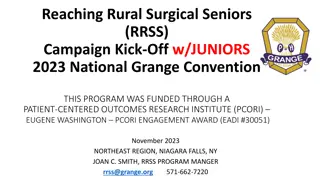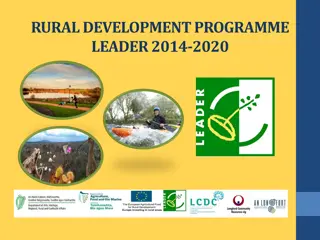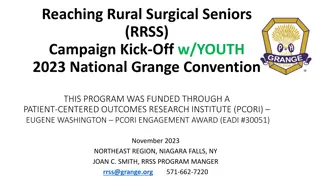Unlocking Opportunities in Rural Transport: A Comparative Review of 2007 and 2018 Strategies
The study compares the rural transport strategies of South Africa from 2007 to 2018, delving into challenges like inadequate infrastructure and low population densities. It explores policy shifts, missed opportunities, and offers recommendations for enhancing rural transport systems to foster socio-economic development and growth.
Download Presentation

Please find below an Image/Link to download the presentation.
The content on the website is provided AS IS for your information and personal use only. It may not be sold, licensed, or shared on other websites without obtaining consent from the author. Download presentation by click this link. If you encounter any issues during the download, it is possible that the publisher has removed the file from their server.
E N D
Presentation Transcript
LOCKED LOCKED- -UP GAINS & MISSED UP GAINS & MISSED OPPORTUNITIES: A RAPID REVIEW OF THE OPPORTUNITIES: A RAPID REVIEW OF THE 2007 & 2018 VERSIONS OF THE RURAL 2007 & 2018 VERSIONS OF THE RURAL TRANSPORT STRATEGY FOR SOUTH TRANSPORT STRATEGY FOR SOUTH AFRICA AFRICA SATC Presentation SATC Presentation July 2018 CSIR International Convention Centre, Pretoria CSIR International Convention Centre, Pretoria Authors: Dr James Chakwizira & Mac Mashiri
PRESENTATION ROADMAP PRESENTATION ROADMAP INTRODUCTION INTRODUCTION Background & Context Study Motivation & Justification Purpose of the Paper RESEARCH METHODOLOGY RESEARCH METHODOLOGY LITERATURE REVIEW & CONCEPTUAL FRAMEWORK LITERATURE REVIEW & CONCEPTUAL FRAMEWORK Notion of Rural Transport Policy / Strategy & Governance Sustainable Livelihoods Approach Theory of Change in RTS Implementation Rural Transportation Systems Analysis Rural Transportation Research Advances & Policy Implications Transport Challenges in Rural SA Towards a Conceptual RTS Framework DISCUSSION OF RESULTS & FINDINGS DISCUSSION OF RESULTS & FINDINGS Policy Shifts, Locked-up Gains & Missed Opportunities Missed Opportunities & Recommendations CONCLUSION CONCLUSION
INTRODUCTION INTRODUCTION Background & Context Rural South Africa experiences multiple challenges (Dawson, 1993; Department of Transport (DOT), 2007; DOT, 2010; Hine, 2014; DOT, 2017) such as: Inadequate infrastructure networks Long travelling & commuting distances Sparse Scattered Dispersed & fragmented settlement patterns, and Low population densities Low population densities create spatial & economic investment inefficiencies with respect to the provision of transportation infrastructure & services (Chakwizira & Mashiri, 2015; Thomas, 2016; Mtizi, 2017). Most rural areas experience differentiated & unique access & mobility challenges in seeking to connect with surrounding & major economic hubs & nodes (results in constrained pathways for socio-economic development & growth) (Chakwizira, Nhemachena & Mashiri, 2008; DOT, 2007; 2017, NATMAP, 2011; Thomas, 2016).
INTRODUCTION INTRODUCTION Study Motivation & Justification DOT s review of the 2007 RTS was predicated on the following (Eliasson & Proost, 2015; Nchabeleng, 2017) : Outcome of the RTS impact assessment conducted in 2013 suggested 2007 RTS needed to address gaps & align with current developments, e.g., incorporating the logic & provisions of important new policies, including amongst others: National Development Plan, Vision 2030 , 2011 New Growth Path, 2011 Draft White Paper on Transport Policy, 2016 National Land Transport Act , 2009 Spatial Planning & Land Use Management Act, 2013 Need for incorporating operational models to enhance rural access & mobility such as the integrated public transport network (IPTN) that addresses missing links in rural transport infrastructure & rural transport services together with a clearly articulated role for NMT
INTRODUCTION INTRODUCTION Purpose of the Paper The purpose of this paper is : to provide a rapid review of both the 2007 & 2018 Rural Transport Strategies (RTS) for South Africa with a view to deepening conversations regarding: Methodological Conceptual Contextual & theoretical gaps that require further attention To generate recommendations to further strengthen the current RTS for improved Implementation; Innovation; Sustainability; and Performance of the rural transport sector in South Africa.
PRESENTATION ROADMAP PRESENTATION ROADMAP INTRODUCTION INTRODUCTION Background & Context Study Motivation & Justification Purpose of the Paper RESEARCH METHODOLOGY RESEARCH METHODOLOGY LITERATURE REVIEW & CONCEPTUAL FRAMEWORK LITERATURE REVIEW & CONCEPTUAL FRAMEWORK Notion of Rural Transport Policy / Strategy & Governance Sustainable Livelihoods Approach Theory of Change in RTS Implementation Rural Transportation Systems Analysis Rural Transportation Research Advances & Policy Implications Transport Challenges in Rural SA Towards a Conceptual RTS Framework DISCUSSION OF RESULTS & FINDINGS DISCUSSION OF RESULTS & FINDINGS Policy Shifts, Locked-up Gains & Missed Opportunities Missed Opportunities & Recommendations CONCLUSION CONCLUSION
RESEARCH METHODOLOGY RESEARCH METHODOLOGY The study employed: Mixed-method approach including a systematic document analysis to paint a picture of the rural transportation status quo Systems & gap analysis framework to isolate & highlight gaps especially in the 2018 RTS as a stepping stone to generating a storyline which provides pointers to turning around the fortunes of rural areas through innovative RTS implementation The analytical methodology was located in, & drew heavily from four inter- related & interconnected concepts, namely: Theory of change (United Nations Children s Fund, 2014) ; Livelihoods approach (Davis, 2005) ; Transport governance system approach (Chakwizira & Mashiri, 2009), , and Transport systems & innovation approach (Morrissey & Browne, 2004).
PRESENTATION ROADMAP PRESENTATION ROADMAP INTRODUCTION INTRODUCTION Background & Context Study Motivation & Justification Purpose of the Paper RESEARCH METHODOLOGY RESEARCH METHODOLOGY LITERATURE REVIEW & CONCEPTUAL FRAMEWORK LITERATURE REVIEW & CONCEPTUAL FRAMEWORK Notion of Rural Transport Policy / Strategy & Governance Sustainable Livelihoods Approach Theory of Change in RTS Implementation Rural Transportation Systems Analysis Rural Transportation Research Advances & Policy Implications Transport Challenges in Rural SA Towards a Conceptual RTS Framework DISCUSSION OF RESULTS & FINDINGS DISCUSSION OF RESULTS & FINDINGS Policy Shifts, Locked-up Gains & Missed Opportunities Missed Opportunities & Recommendations CONCLUSION CONCLUSION
LITERATURE REVIEW & CONCEPTUAL FRAMEWORK LITERATURE REVIEW & CONCEPTUAL FRAMEWORK Notion of Rural Transport Policy / Strategy & Governance This paper has adopted the concept & notion of rural transport implementation policy & strategy tools that relates to & depicts the available means for governments to influence or coerce business & citizens in a desired direction (Mercier et al, 2016). Rural transport policy/strategies & governance are understood to comprise goals, decisions, actions, & inactions that are important in governing a rural transport system (Smith, 1976; Jenkins, 1978; Pierre & Peters, 2000; Hill, 2005; Pierre, 2011). Rural transport policy/strategy is therefore based on a fluid concept that recognizes the centrality of transport governance in rural transport performance.
LITERATURE REVIEW & CONCEPTUAL FRAMEWORK LITERATURE REVIEW & CONCEPTUAL FRAMEWORK Sustainable Livelihoods Approach Approaches to rural transportation development can take either a physical target-based approach or a traffic-based transport cost savings approach (Hine, 2014 p3). This calls into focus the need for differentiated & yet targeted approaches, as well as intervention & program monitoring systems to maximize rural transportation gains. These gains can best be unravelled within the ambit of the Sustainable Livelihoods Approach which has the capacity to express more meaningfully the relationship between transport provision & poverty (Davis, 2005). This approach recognizes the importance of assets in sustaining rural livelihoods & creating enabling conditions to reduce the vulnerability of the poor to different types of shocks (Hine, 2014 p10).
LITERATURE REVIEW & CONCEPTUAL FRAMEWORK LITERATURE REVIEW & CONCEPTUAL FRAMEWORK Theory of Change in RTS Implementation A simplified representation of the Rural Transport Policy / Strategy Theory of Change is depicted in Figure 1. Assumptions Assumptions Inputs Inputs Activities Activities Outputs Outputs Outcomes Outcomes Impacts Impacts External Factors External Factors The theory explicitly states the assumptions that underpin the causal linkages illustrating the range of impacts, activities & outputs that feed into the broad set of desired outcomes (SACN, 2014 p36-37) In this way, rural transportation planning policy / strategy transformation becomes a process & not an event, thus requiring transitional change management tactics & leadership.
LITERATURE REVIEW & CONCEPTUAL FRAMEWORK LITERATURE REVIEW & CONCEPTUAL FRAMEWORK Rural Transportation Systems Analysis Systems engineering models can be based on cost-benefit analysis, life cycle analysis & multi-criteria decision analysis (Morrissey & Browne, 2004). Assessment tools for these systems include management information systems, decision support systems, expert evaluation systems, socioeconomic & environmental assessments (Kamperis et al, 2013). The point is to think of rural transport as a system in equilibrium with many interacting components. Key outputs are mobility rates, the distance people have to walk to roads & access services, goods traffic levels, transport fares & tariffs & the availability of different modes
LITERATURE REVIEW & CONCEPTUAL FRAMEWORK LITERATURE REVIEW & CONCEPTUAL FRAMEWORK Rural Transportation Research Advances & Policy Implications The most widely quoted research work with respect to the impact of rural roads has been work carried out by the International Food Policy Research Institute (IFPRI) under the leadership of Professor Shenggen Fan making use of a benefit-cost ratio approach A key result of several IFPRI studies is that rural roads are second to agricultural interventions/research in terms of benefit-cost ratio of expenditures summary of key findings across IFPRI studies relating to the impact of rural roads. Benefit / cost ratio of expenditure on increasing length 6.37 1.45 3.03 0.86 9.13 7.16 - No. of people out of poverty with $10,000 (2011 prices) road investment 10.5 0.1 32.9 30.2 170 261 31.5 20 9.6 Country Road Type Road sector ranking Sector with highest returns Low quality High quality Rural roads Rural roads Rural roads Feeder roads (gravel) Tarmac Rural roads - - - - China India Thailand Tanzania 1st 3rd 2nd 2nd - Roads Agricultural research & others Agricultural research & others Agricultural research & others Uganda Vietnam 3.01 2nd Agricultural research & others Sources: Fan, Hazell & Thorat (1999); Fan & Chan-Kang (2004); Fan, Zhang & Rao (2004); Fan, Nyange & Rao (2005); Fan, Jitsuchon & Methakunnavut (2004); Raballand et al. (2009); Hine (2014)
LITERATURE REVIEW & CONCEPTUAL FRAMEWORK LITERATURE REVIEW & CONCEPTUAL FRAMEWORK Towards a Conceptual RTS Framework The framework revolves around the need to sustainably scale rural access & mobility barriers by intervening at three levels: the personal system & socio-economic opportunity levels The levels need to be guided by spatial development principles to unlock development impulses to achieve transformative rural development.
Rural Transportation Infrastructure & Services Development Barriers & Constraints Governance Resilience & Capacity Spatial Destination Origin (User) First & Last Mile Access & Mobility Constraints Sustainability Structural Spatial BARRIERS & CONSTRAINTS BARRIERS & CONSTRAINTS Cost of Amenity Income Levels Transport Modes & Modal Choice Level of Service Funding Cost Time Poverty Connectivity Spatial Justice Distance Information Hours of Operation Gender Transport Infrastructure Reliability Governance Technology & Innovation Good Vulnerable Groups Quality of Amenity Critical Mass Spatial Geography Economic Opportunities & Market Access Assets (incl. transport) Settlement Forms, Patterns & Structures psychological Efficiency Spatial Socio- Unlocking Locked-up Gains & Missed Opportunities for Transformative Rural Socio-economic Development
PRESENTATION ROADMAP PRESENTATION ROADMAP INTRODUCTION INTRODUCTION Background & Context Study Motivation & Justification Purpose of the Paper RESEARCH METHODOLOGY RESEARCH METHODOLOGY LITERATURE REVIEW & CONCEPTUAL FRAMEWORK LITERATURE REVIEW & CONCEPTUAL FRAMEWORK Notion of Rural Transport Policy / Strategy & Governance Sustainable Livelihoods Approach Theory of Change in RTS Implementation Rural Transportation Systems Analysis Rural Transportation Research Advances & Policy Implications Transport Challenges in Rural SA Towards a Conceptual RTS Framework DISCUSSION OF RESULTS & FINDINGS DISCUSSION OF RESULTS & FINDINGS Policy Shifts, Locked-up Gains & Missed Opportunities Missed Opportunities & Recommendations CONCLUSION CONCLUSION
DISCUSSION OF RESULTS & FINDINGS DISCUSSION OF RESULTS & FINDINGS Policy Shifts, Locked-up Gains & Missed Opportunities The Table presents a comparison & gap analysis of the 2007 & 2018 rural transport strategy documents with a focus on policy shifts, locked-up gains & missed opportunities within the broader ambit of the conceptual framework While efforts have been made to update the 2018 RTS to accord with current contextual realities, critical components of the strategy have not been taken to their logical conclusion This has the effect of & potential for compromising the realisation of the strategic intent of the RTS suggesting inadequate Rural Transport Policy / Strategy exploitation of locked-up gains leading to unfulfilled potential By extension, this suggests missed opportunities for utilising the RTS review process to generate an innovative, integrative & transformative instrument for rural socio-economic development.
DISCUSSION OF RESULTS & FINDINGS DISCUSSION OF RESULTS & FINDINGS Policy Shifts, Locked-up Gains & Missed Opportunities Rural Transport Strategy for South Africa (2007) for South Africa (2018) Strategic direction provided by relatively conservative, traditional & welfare- oriented planning instruments such as the National Spatial Development Perspective (2006) & Integrated Strategic Rural Development Program (ISRDP) economically productive units/areas. Criteria / Indicator Policy Alignment Rural Transport Strategy Gaps & Missing Dimensions The document is silent on the rural transport links to Sustainable Development Goals (SDGs) & yet it is common cause that in order to achieve many of the goals, transportation is indeed a crucial ingredient. Rural transport low carbon transitions framework realities have also been inadequately tackled. New Shifts Incorporated Strategic direction provided by a range of progressive policies & legislative instruments including the NDP 2030 (2011), & the Comprehensive Rural Development Program (CRDP), which perceive rural areas as potential socio- New policy & legislation directions as captured by documents such as the National Land Transport Strategic Framework (2015), NATMAP 2050 (2012) & Public Transport Strategy for South Africa (2007) which tend to emphasize socio-economic development & not welfare alone have been incorporated.
DISCUSSION OF RESULTS & FINDINGS DISCUSSION OF RESULTS & FINDINGS Policy Shifts, Locked-up Gains & Missed Opportunities Criteria / Indicator Policy Elements RTS for South Africa (2007) Addressing rural poverty enclaves & stricken nodes & rural community & population needs requires the application of a uniform & standardised approach to rural transportation infrastructure & services delivery. Gaps & Missing Dimensions Full life-cycle analysis & intervention logic for valorising differentiated rural transportation targeted interventions is inadequately developed There is also an assumption that rural municipalities are adequately capacitated to conduct oversight & implementation activities in support of the new RTS. RTS for South Africa (2018) New Shifts Incorporated The uniqueness of the rural spatial geography in South Africa demands the application of a differentiated rural transportation infrastructure & services delivery approach for various typologies of rural settlements. Invariably, appropriate solutions include a variety of suitable & customised mix of relevant interventions. 2018 RTS offers rural transportation opportunities in: oImplementing high potential development & investment in rural areas taking into account individual rural spaces, unique transportation conditions & development requirement oAddressing & responding to intermediate type rural transportation development requirements oAddressing rural transportation access & mobility as a basic development service & requirement in rural communities
DISCUSSION OF RESULTS & FINDINGS DISCUSSION OF RESULTS & FINDINGS Policy Shifts, Locked-up Gains & Missed Opportunities Criteria / Indicator Implementati on Models RTS for South Africa (2018) The model is based on a network development approach which recognises the need to provide for missing links in transportation infrastructure & services. While more emphasis is placed on the need to implement a varied investment approach, detailed implementation details on this are not provided. New Shifts Incorporated Emphasis is now on the deployment of a range of rural transportation interventions underpinned by a varied, but rich investment approach RTS for South Africa (2007) Gaps & Missing Dimensions The Integrated Rural Mobility & Access model was piloted in 6 DMs municipalities. The approach also laid emphasis on using the brokering of logistics & transportation services to catapult rural development which was highly dependent on private sector participation & public sector collaboration. In reality, once the funded demonstration projects had run their course, there was no adoption of approach by implementing agencies, not least because of funding inadequacies, legislative challenges, capacity & governance & commitment issues. It is important to note here the considered view that new roads, networks links are not enough is still very relevant. In other words, other interventions that impact on development across all the sectors are also simultaneously required. At the same time, the implementation framework expected to provide guidance for rural transportation development has inadequate information & guidance for municipalities to use in supporting the vision & strategic intent of the RTS.
DISCUSSION OF RESULTS & FINDINGS DISCUSSION OF RESULTS & FINDINGS Policy Shifts, Locked-up Gains & Missed Opportunities Criteria / Indicator Public Transport Services promotion approach Sustainable Rural transportation Systems RTS for South Africa (2007) The development of an effectively interlinked network of multi-purpose nodes & linkages in DMs Develop demand- responsive, balanced & sustainable rural transport systems. New Shifts Incorporated Need to promote IPTNs in rural areas RTS for South Africa (2018) Gaps & Missing Dimensions Promote quality public transport services by way of IPTN within district municipalities The lack of a scaled approach regarding how the implementation of the IPTN in rural areas should be conducted. Lack of a clear municipal framework for operationalising the differentiated rural transportation systems & services approach. No explicit reference is made to greenhouse gas emissions particularly because regional corridors, often laden with heavy traffic pass through rural areas. Promote nodal linkages & demand responsive transport services Recognition of the need for a differentiated rural transportation approach. The focus on non- motorised transport is encouraging in terms of low carbon planning. Promote coordinated rural nodal & linkage development (implied rather than explicitly tackled). Guide corridor development through sustainable rural investment plan (implied rather than explicitly tackled). Green rural Transport Infrastructures & services planning
DISCUSSION OF RESULTS & FINDINGS DISCUSSION OF RESULTS & FINDINGS Policy Shifts, Locked-up Gains & Missed Opportunities Criteria / Indicator Issues Relating to Gender & Other Vulnerable Groups New Shifts Incorporated While these issues are found in both documents, they do not go far enough Gaps & Missing Dimensions A much more thorough discussion of gender issues with particular reference to women & other vulnerable groups together with appropriate intervention regimes is certainly required. RTS for South Africa (2007) RTS for South Africa (2018) Generally the elderly, women & persons with disabilities are being left behind through the urban-rural migration phenomenon. In addition, in terms of demographic makeup, there are largely more women than men in rural South Africa. These population segments were not clearly & specifically tackled in the discussion & range of interventions. Climate change is a reality & affects rural & urban communities alike. There was no discussion of this phenomenon at all. Generally the elderly, women & persons with disabilities are being left behind through the urban-rural migration phenomenon. In addition, in terms of demographic makeup, there are largely more women than men in rural South Africa. These population segments were not clearly & specifically tackled in the discussion & range of interventions. Climate change is a reality & affects rural & urban communities alike. There was no discussion of this phenomenon at all, including rural transport s relationship with disaster management Climate change not incorporated Need to strengthen the relationship between disaster management & rural transportation endeavours Climate Change Issues
DISCUSSION OF RESULTS & FINDINGS DISCUSSION OF RESULTS & FINDINGS Policy Shifts, Locked-up Gains & Missed Opportunities Rural Transport Strategy for South Africa (2007) While connecting the rural population to production centres in rural towns, forestry & agricultural enclaves is crucial to socio- economic advancement, the space economy was not mapped the emphasis being on fulfilling the needs of a welfare economy first. Criteria / Indicator Rural Transport Strategy for South Africa (2018) New Shifts Incorporated Gaps & Missing Dimensions While connecting the rural population to production centres in rural towns, forestry & agricultural enclaves is crucial to socio- economic advancement, the space economy was not mapped the emphasis being on fulfilling the needs of a welfare economy first. Mapping the space economy not attempted The need to map the space economy cannot be over- emphasized as both the welfare & the productive economies are important for socio-economic development of rural areas. This should be linked to the broader discussion on land redistribution which has since gathered momentum It should also be linked to agricultural value chains & the decisive role that rural transportation plays in this space Mapping the Space Economy
DISCUSSION OF RESULTS & FINDINGS DISCUSSION OF RESULTS & FINDINGS Policy Shifts, Locked-up Gains & Missed Opportunities Critical questions to assist in anchoring this rural transportation intervention: Is the rural IPTN intervention option as currently configured (urban-oriented except for differences in scale, size & interventions) the best value for money or should we still be looking for other derivations? Given that public transport budgets in urban & rural areas has over the years been declining, what assurance do we have that these budgets will be increased to fund rural IPTNs? Is it not perhaps more pragmatic to focus on improving existing forms of public transport as typified by Mthatha in which taxis are organised to deliver a functionally appropriate transport service rather than replace this with a new & perceived better public transport system in the form of an IPTN? Is the IPTN viable in areas without economic opportunities or even the required demand thresholds? Is there no merit in looking at options for the incremental introduction of IPTN if that is the only option available? & What criteria will be used in identifying qualifying rural areas or municipalities for the implementation of the IPTN & what are the public transport demand thresholds justifying the implementation of such projects in rural areas?
DISCUSSION OF RESULTS & FINDINGS DISCUSSION OF RESULTS & FINDINGS Missed Opportunities & Recommendations INTERVENTION Addressing emergent challenge on enabling people to maintain their independence for longer through a wide choice of safe & easily accessible transport modes & services Minibuses Vehicles with ramps/tail lift to provide transport for the elderly, frail & persons with disabilities who cannot easily climb steps. Explore such opportunities for rural South Africa. LDVs Proactively take the demonstration projects that were abandoned some years back forward & explore legislative & Vehicle design changes especially for deep rural areas Rural travel-link Innovations Expansion of the established service which assists patients needing advice about transport to health appointments, & to assess those requesting an ambulance. This would take forward the logistics & transportation brokering intervention option that appears in both the RTS iterations. It would unlock the locked-up opportunity that never took off. Accessible footpaths & routes Dropped kerbs, Raised crossings, Tactile paving, Widened footways especially in rural areas in addition to well-formed paths, low level & foot bridges. The momentum that was created has waned & needs to be revived with the new strategy. Could be associated with a network of tourism hiking-biking trails linking socio-economic opportunities Appropriate road, street & hiking trail furniture Setting up guidance on rural roads & streets for rural municipalities in South Africa MISSED OPPORTUNITIES Dial-a-Ride (Uber-type) Development of rural road infrastructure master plan Rural transport educational safety campaigns for older adults & vulnerable groups in rural areas. Increase efforts to cover other groups as well Road maintenance Road safety seminars for older adults & children
DISCUSSION OF RESULTS & FINDINGS DISCUSSION OF RESULTS & FINDINGS Missed Opportunities & Recommendations INTERVENTION Facilitate education & economic participation amongst the young & working-age population in rural areas through a range of services & easy, safe & sustainable access to services in nearby areas Walking & cycling routes & facilities especially to & from other transport nodes such bus interchanges/stops & train stations & nearby towns & nodes. Safer routes to schools Identify & develop pedestrian routes for children to travel to & from schools & recreational activities with better personal & road safety in mind. DESCRIPTION MISSED OPPORTUNITIES Identify potential pedestrian & cycle routes & facilities National walking & cycling or Bike Master Plan Safer routes to schools program, walking especially in rural towns, intensifying Build capacity through the Shova Kalula Partnership Bicycle Program buses As identified in the Road Safety Strategy & the Cycling Strategy, promote cycle training, especially amongst school-age children Cyclist safety training
DISCUSSION OF RESULTS & FINDINGS DISCUSSION OF RESULTS & FINDINGS Missed Opportunities & Recommendations INTERVENTIONS Reduce the overall need to travel & provide viable alternatives to the automobile in rural areas Developing guideline documents for local authorities Pedestrian safety measures Enhance sustainable access to local urban nodes, small- medium sized rural towns & areas Cycle parking & infrastructure Passenger transport joint-working partnerships MISSED OPPORTUNITIES Walking routes Developing guideline documents for local authorities Develop walking & cycling interventions for local authorities Developing guideline documents for local authorities Quality network partnership for rural passenger transport in local authorities Rural transportation infrastructure master plan Passenger transport infrastructure maintenance & development Access to train stations Technology improvements (Internet) Speed reduction Rural Rail Station Travel Plans Rural Fibre Broadband Strategy Interventions as set out in the Municipal Speed Compliance Strategy
DISCUSSION OF RESULTS & FINDINGS DISCUSSION OF RESULTS & FINDINGS Missed Opportunities & Recommendations INTERVENTION MISSED OPPORTUNITIES Maintain rural areas as attractive places to live, work & visit Cleanest Rural Areas Award Promotional rural tourism & investment campaigns Street cleanliness & appearance Promote rural municipalities to businesses, tourists & other countryside users Use publicity & travel planning to inform people living & working in the rural wards of the opportunities available to them with regards to transport choice & the benefits associated with their use Travel plans Interventions as set out in Municipal s Sustainable Modes of Travel Strategy National Walking, Bike & Public Transport to Work Week. Personalised journey planning Rural public space making, branding & marketing Events Targeted interventions Promote use of public places
PRESENTATION ROADMAP PRESENTATION ROADMAP INTRODUCTION INTRODUCTION Background & Context Study Motivation & Justification Purpose of the Paper RESEARCH METHODOLOGY RESEARCH METHODOLOGY LITERATURE REVIEW & CONCEPTUAL FRAMEWORK LITERATURE REVIEW & CONCEPTUAL FRAMEWORK Notion of Rural Transport Policy / Strategy & Governance Sustainable Livelihoods Approach Theory of Change in RTS Implementation Rural Transportation Systems Analysis Rural Transportation Research Advances & Policy Implications Transport Challenges in Rural SA Towards a Conceptual RTS Framework DISCUSSION OF RESULTS & FINDINGS DISCUSSION OF RESULTS & FINDINGS Policy Shifts, Locked-up Gains & Missed Opportunities Missed Opportunities & Recommendations CONCLUSION CONCLUSION
CONCLUSION CONCLUSION 2018 RTS is a strategic document designed to integrate & inform all transport & land use related decision-making in rural SA with a view to ensuring that rural transport investments support the socio-economic agenda of the country RTS seeks to achieve this within a broadly defined integrated development framework that takes cognizance of the complex intertwining relationship between the rural transport sector on the one hand, & communities, the economy, the built & natural environments 2018 RTS vision & intervention options needs to be the cornerstone of a robust implementation agenda to ensure that the RTS intervention options not only find traction across all rural development partners, but are also indeed implemented In this regard, the paper has enumerated some of the missed opportunities & locked-up gains that could indeed be exploited by the 2018 RTS version to ensure widespread impact & that no one is left behind
Thank You! Thank You!


